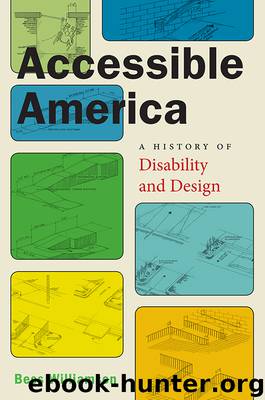Accessible America by Bess Williamson

Author:Bess Williamson
Language: eng
Format: epub
Publisher: NYU Press
6
From Accessible to Universal
Design in the Late Twentieth Century
In the last decades of the twentieth century, disability rights reached the mainstream of American culture with conflicting success. On the one hand, disabled people were increasingly present in the public view: organizing in political groups, taking up leadership roles in government and social service agencies, and speaking for themselves in media venues that had previously focused a pitying or “inspiring” lens on disabled subjects. On the other hand, as disability issues came to the fore, so did backlash against the causes of inclusion and civil rights. Accessible design was an easy target for criticism. Some of the earliest public measures for access involved difficult and awkward renovations of public buildings—such as courthouses, train stations, and libraries—which were otherwise perceived as grand and stately forms of architecture.1 In public transportation, decades-long renovation projects similarly provided a poor public face for the cause of access. The regulations of the 1970s and 1980s were unevenly enforced and often confusing for architects and builders: with differing timelines of enforcement coded in the fine print of accessibility regulations, government specifications were not widely embraced, and by the time of the passage of the Americans with Disabilities Act (ADA) in 1990 there were few elegant or monumental examples.2
The designers who worked to promote and improve accessible design were dismayed by its poor public image. After the passage of the ADA, Ronald L. Mace, an architect and longtime advocate of accessible design, lamented having to defend “this stuff … being put out as what it means to comply with the ADA,” given that “the buildings end up looking like hell.” For Mace, one of the few American architects of the 1970s who used a wheelchair himself, it was the “ultimate frustration” to see buildings where architects and engineers tacked on access features only when they realized the need to comply with government regulations. These buildings “ended up being discriminatory after all,” Mace argued, because this “added on” access usually did not work well, if at all, and seemed to reinforce the message that people with disabilities were a marginal afterthought.3
For decades before the passage of the ADA, Mace had argued that design that included disabled people did not need to be an unattractive and expensive addition to “standard” design. After completing his architectural training at North Carolina State University in 1966, Mace consulted first with local, then federal agencies to develop guidelines for accessible architecture, and often performed the architectural work of planning renovations for public agencies after the laws went into effect.4 While his work often focused on helping local agencies meet legal guidelines, he argued that these requirements were just a starting point for well-considered design. Mace is credited with coining the term “Universal Design,” an ideal of design that is “usable by all people” rather than the kind of separate facilities often employed to provide access.5 The term gave a name to the idea that many designers, engineers, medical specialists, and individuals with disabilities had
Download
This site does not store any files on its server. We only index and link to content provided by other sites. Please contact the content providers to delete copyright contents if any and email us, we'll remove relevant links or contents immediately.
| Anthropology | Archaeology |
| Philosophy | Politics & Government |
| Social Sciences | Sociology |
| Women's Studies |
The Secret History by Donna Tartt(18818)
The Social Justice Warrior Handbook by Lisa De Pasquale(12128)
Thirteen Reasons Why by Jay Asher(8773)
This Is How You Lose Her by Junot Diaz(6764)
Weapons of Math Destruction by Cathy O'Neil(6121)
Zero to One by Peter Thiel(5664)
Beartown by Fredrik Backman(5578)
The Myth of the Strong Leader by Archie Brown(5407)
The Fire Next Time by James Baldwin(5229)
How Democracies Die by Steven Levitsky & Daniel Ziblatt(5113)
Promise Me, Dad by Joe Biden(5079)
Stone's Rules by Roger Stone(5015)
A Higher Loyalty: Truth, Lies, and Leadership by James Comey(4826)
100 Deadly Skills by Clint Emerson(4825)
Rise and Kill First by Ronen Bergman(4690)
Secrecy World by Jake Bernstein(4625)
The David Icke Guide to the Global Conspiracy (and how to end it) by David Icke(4609)
The Farm by Tom Rob Smith(4425)
The Doomsday Machine by Daniel Ellsberg(4402)
